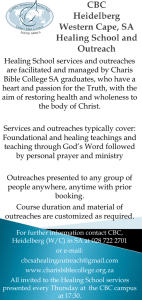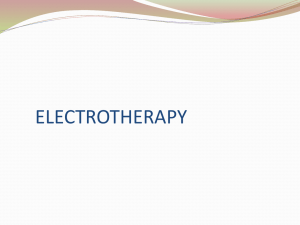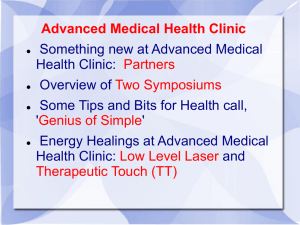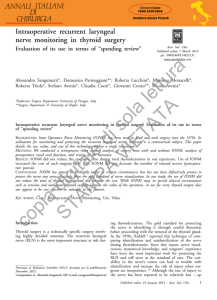Therapeutic techniques
advertisement
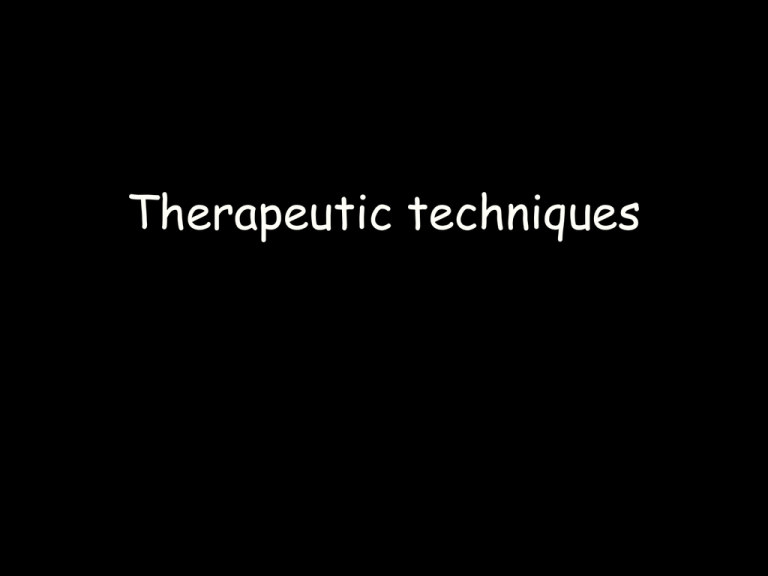
Therapeutic techniques General principles: • Aims: – Reduce pain; – Regain full use & movement of an injured area; – Restore or enhance strength. • Some treatment methods help speed up the healing process. • In many cases, conventional medicine is insufficient to cure a lameness / injury. • Alternatives methods and high-tech therapies can be used. • Complementary therapies are often used, but will be reviewed in a later session. Types of therapies Physical therapies, e.g.: – Flexing & extending limbs (stretches); – Massage / equine sports massage therapy; – Chiropractic; – Osteopathy; – Manipulation; – Controlled exercise / rest; – Riding / groundwork; – Foot balancing and / or corrective shoeing; – Nutrition; – Poultices; – Hot &/ cold therapy. Veterinary / hi-tech therapies, e.g.: – – – – – – – – – – Drugs; Surgery; Hydrotherapy; Magnetic therapy; Ultrasound; Laser therapy; TENS; Shockwave treatment; Inferential treatment; Stem cell therapy. Areas for consideration: • Identification of techniques; • When to use / not to use different techniques / suitability for different injuries; • Effects of techniques; • Effectiveness / success; • Cost; • Length of treatment; • Accessibility / availability; • Equipment & people required; • Case studies. Pain relief • Example of drug: • Bute (phenylbutazone) = non-steroidal, antiinflammatory drug. – acts directly on musculoskeletal tissue – controls inflammation – reduces secondary inflammatory damage – alleviates pain – helps restore range of motion. • Can cause side effects, e.g. liver / kidney damage, etc. Pain relief • Example of technological method: • Transcutaneous Electrical Nerve Stimulation (TENS). • Also – electrical muscle stimulation (EMS), electroanalgesia, lasers & ultrasound. • Injury causes muscle tension & decrease in blood flow. • This causes the build-up of waste products at the injury site. • Pain relief limits the inflammatory response, enabling quicker healing. • Stimulate circulation to tissues (for oxygen, nutrients & removal of waste products). T.E.N.S • Used primarily for pain relief • Used frequently and almost anywhere on horse • Used on either side of lesions • Over nerve roots • Over peripheral nerve • At trigger points / acupuncture points Hot and cold therapy • • • • • Relieving pain Relieving muscle spasms Different roles Cooling for immediate injuries 48 hours later benefits from heat treatment • Cold diminishes healing at later stage • Heat encourages swelling, cold discourages Risks Inherent in Cold Therapy • Damage to local tissues incl. Burns • If area has damage to autonomic nerves, tissue cooling occurs more rapidly and more deeply Heat Therapy • • • • • • Pain relief Sedative effect Encourages healing Increase in range of motion Hot packs Infrared Hydrotherapy Hydrotherapy Magnetic Therapy • Static – Boots – Rugs • Electromagnetic Electromagnetic stimulation • Allegedly improves oxygen supply & increases temperature. • An electrical current applied across a bone fracture site can help stimulate bone repair, reduce healing time & improve final union of the fractured bone. • A fracture site induces a negative polarity electrical charge, and is particularly useful where there is non-union of the fracture. • Direct current – applied via implanted electrodes (invasive). • Pulsing electromagnetic fields (PEMFs) – a current is passed through special circular coils that are placed either side of the bone. The pulse can be varied in size, shape & rate. • Portable, rechargeable & mains-operated systems are available. • Biomagnetic, flexible, rubber / plastic pads surrounding a foil are also used. The foil contains a magnetised iron compound. Laser • LASER (Light Amplification by the Stimulated Emission of Radiation) • 2 main types: high-energy (hot) & low-energy (cold). • High-energy – light-beam capable of cutting & burning tissues. • Used to treat the base of the wound after surgical removal of a tumour / tissue mass, but can also be used to remove them. Laser • Low-energy – a more recent innovation. Used mainly for physiotherapy, cosmetic surgery & acupuncture. • • Mainly used for treatment of soft tissue injuries • Re-establish lymph flow • Enhances circulatory flow • Pain relief • Regeneration of nerve • Little scientific data to substantiate claims of accelerating healing – not known how it occurs. Uses of Laser • • • • • • Tendon and ligament injuries Oedema Pain reduction Nerve compression or bruising Open and post surgical wounds Not for use around the eye nor in pregnant mares LLLT Day 1 Day 15 Day 28 Pharmacology • The science of drugs – divided into 2 parts: • Pharmacodynamics – the study of the way in which the functions of the living body are affected by drugs. • Pharmacokinetics – the absorption, metabolism & excretion of drugs by the body. • Therapeutics = rational & optimal use of drugs in the management of disease states or in the manipulation of physiological functions. • Drug classification • Often classified according to: • The way in which they bring about their effect on the body, and • Which body system or infective agent they affect. Acupuncture / acupressure • High-tech methods of stimulating the acupuncture points are: – – – – heat application; laser radiation; electrical stimulation; injection of drugs / saline to prolong stimulation of the nerve. Surgery • There are many different forms & procedures, dependent on the problem, e.g. respiratory tract, gastro-intestinal tract, urogenital tract, hernias, castration etc. • No guarantee of success – many complications can arise. • Need to consider the cost of surgery compared to the value of the animal & extent of possible recovery & future use. The operating theatre Padded induction / recovery room Laparascopic surgery • • • • Laparoscopic surgery is available for minimally invasive surgery Used for cryptorchid surgery, removal of stones in the urinary bladder, amongst other problems. While specific procedures may require general anesthesia, other procedures can be performed with only sedation and local anesthetic blocks. Because of the small incisions that are made with this technique, many horses are able to return to athletic usefulness much faster than if traditional surgery had been utilised. Fracture Repair • Vets are becoming more knowledgeable in assessment and repair of fractures in horses. • Repair of long bone fractures in the leg is facilitated by anesthetic recovery in a hydropool, greatly decreasing the risk of injury or refracture during recovery. Cryosurgery • Local application of intense cold to destroy tissues. • Tissue is rapidly frozen to -20C (-4F) or lower, then slowly thawed, then refrozen (number of cycles depending on type of tissue / depth of required penetration / overall area). • Freezing causes the water content of cells to form ice, swelling the cell, followed by death & rupture of the cell membranes. • The frozen tissues die & gradually slough off to leave a healthy, granulating wound. • Frequently used for removal of skin tumours, e.g. sarcoids, and also exuberant granulation tissue & cataract extraction. • Can be used for neurectomy of the lower limb. • Has proven to decrease the number of treatments per case & reduces the incidence of recurrence at the original site. Ultrasound • Heats deeper / larger / denser musculoskeletal components. • Relaxes aching muscles & improves circulation. • Reduces spasm in muscles & tendons. • Useful in cases of arthritis or constrictive scar tissue. • Used as either a continuous wave or a pulse at regular intervals. • Often combined with cold therapy. • Ideally followed by physical therapy • Do not use over open / contaminated wounds – can drive bacteria further into the tissues. Ultrasound • When to use • When not to use Soft tissue sport injuries Surgical wounds Chronic arthritis Circulatory problems Scar tissue X Tumours X Recent haemorrhaging X Pregnant uterus X Epiphyseal plates • Electroanalgesia • Similar to TENS, but uses different frequencies. Low & high frequencies are available. • Electrical output is mildly amplified to produce visible muscle twitches. • Electrical muscle stimulation • EMS exercises & strengthens atrophied muscles by passively producing muscle contractions. • Can exercise a limb without it having to be weightbearing & without undue stress while healing. • Improves circulation, therefore enhancing the healing process. Shockwave Therapy • Extracorporeal high-energy shock wave therapy is a non-invasive and repeatable method of treatment with hardly any side effects that has been successfully used in the treatment of the locomotor apparatus of man for many years. Shockwave therapy is useful for a number of conditions causing lameness in the horse. These conditions include: • Suspensory ligament disease • Bowed tendons • Ringbone • Bone spavin • Bucked shins • Splints • Fractured splint bones • Sore backs • Navicular syndrome • Fractures not healing properly Shock Wave • During the treatment, a total of approximately 7501500 shock waves are applied. • The ultrasound localization and/or bio-feedback gridscan technique employed allows the target area to be precisely scanned step by step and exposed to about 200-300 shock waves at a time. • Treatment is generally started at a low energy level allow the horses to get used to the shock waves. • In the course of the treatment session, the energy level can be gradually increased. • The entire therapy takes about 20 minutes and is repeated two to three times, in an interval of three to six weeks, according to the diagnosis and the healing process. • Slight sedation has proved useful to calm the horse .



